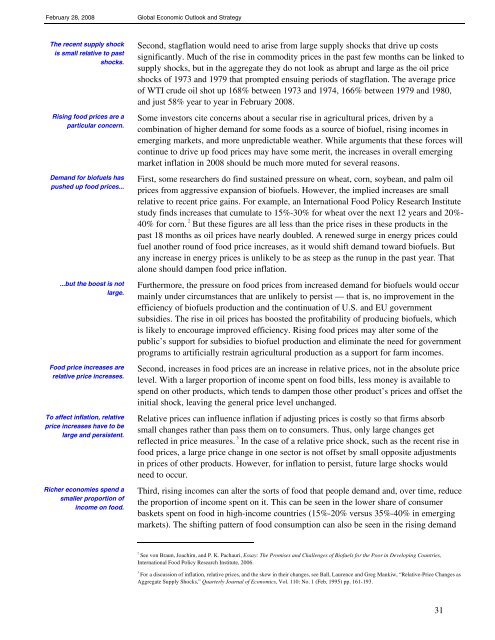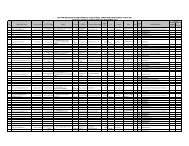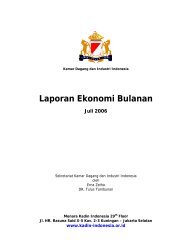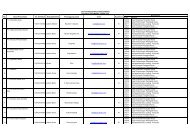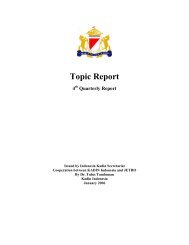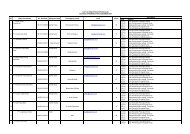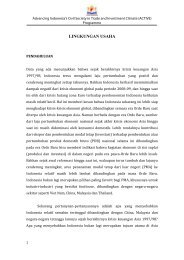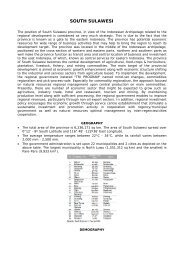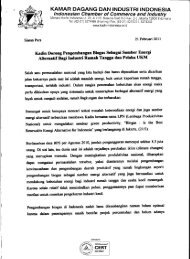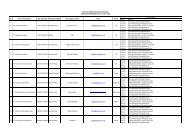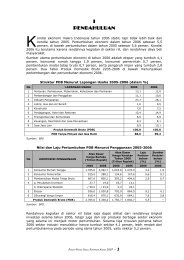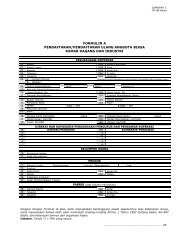Global Economic Outlook and Strategy - Kadin Indonesia
Global Economic Outlook and Strategy - Kadin Indonesia
Global Economic Outlook and Strategy - Kadin Indonesia
Create successful ePaper yourself
Turn your PDF publications into a flip-book with our unique Google optimized e-Paper software.
February 28, 2008<br />
<strong>Global</strong> <strong>Economic</strong> <strong>Outlook</strong> <strong>and</strong> <strong>Strategy</strong><br />
The recent supply shock<br />
is small relative to past<br />
shocks.<br />
Rising food prices are a<br />
particular concern.<br />
Dem<strong>and</strong> for biofuels has<br />
pushed up food prices...<br />
...but the boost is not<br />
large.<br />
Food price increases are<br />
relative price increases.<br />
To affect inflation, relative<br />
price increases have to be<br />
large <strong>and</strong> persistent.<br />
Richer economies spend a<br />
smaller proportion of<br />
income on food.<br />
Second, stagflation would need to arise from large supply shocks that drive up costs<br />
significantly. Much of the rise in commodity prices in the past few months can be linked to<br />
supply shocks, but in the aggregate they do not look as abrupt <strong>and</strong> large as the oil price<br />
shocks of 1973 <strong>and</strong> 1979 that prompted ensuing periods of stagflation. The average price<br />
of WTI crude oil shot up 168% between 1973 <strong>and</strong> 1974, 166% between 1979 <strong>and</strong> 1980,<br />
<strong>and</strong> just 58% year to year in February 2008.<br />
Some investors cite concerns about a secular rise in agricultural prices, driven by a<br />
combination of higher dem<strong>and</strong> for some foods as a source of biofuel, rising incomes in<br />
emerging markets, <strong>and</strong> more unpredictable weather. While arguments that these forces will<br />
continue to drive up food prices may have some merit, the increases in overall emerging<br />
market inflation in 2008 should be much more muted for several reasons.<br />
First, some researchers do find sustained pressure on wheat, corn, soybean, <strong>and</strong> palm oil<br />
prices from aggressive expansion of biofuels. However, the implied increases are small<br />
relative to recent price gains. For example, an International Food Policy Research Institute<br />
study finds increases that cumulate to 15%-30% for wheat over the next 12 years <strong>and</strong> 20%-<br />
40% for corn. 2 But these figures are all less than the price rises in these products in the<br />
past 18 months as oil prices have nearly doubled. A renewed surge in energy prices could<br />
fuel another round of food price increases, as it would shift dem<strong>and</strong> toward biofuels. But<br />
any increase in energy prices is unlikely to be as steep as the runup in the past year. That<br />
alone should dampen food price inflation.<br />
Furthermore, the pressure on food prices from increased dem<strong>and</strong> for biofuels would occur<br />
mainly under circumstances that are unlikely to persist — that is, no improvement in the<br />
efficiency of biofuels production <strong>and</strong> the continuation of U.S. <strong>and</strong> EU government<br />
subsidies. The rise in oil prices has boosted the profitability of producing biofuels, which<br />
is likely to encourage improved efficiency. Rising food prices may alter some of the<br />
public’s support for subsidies to biofuel production <strong>and</strong> eliminate the need for government<br />
programs to artificially restrain agricultural production as a support for farm incomes.<br />
Second, increases in food prices are an increase in relative prices, not in the absolute price<br />
level. With a larger proportion of income spent on food bills, less money is available to<br />
spend on other products, which tends to dampen those other product’s prices <strong>and</strong> offset the<br />
initial shock, leaving the general price level unchanged.<br />
Relative prices can influence inflation if adjusting prices is costly so that firms absorb<br />
small changes rather than pass them on to consumers. Thus, only large changes get<br />
reflected in price measures. 3 In the case of a relative price shock, such as the recent rise in<br />
food prices, a large price change in one sector is not offset by small opposite adjustments<br />
in prices of other products. However, for inflation to persist, future large shocks would<br />
need to occur.<br />
Third, rising incomes can alter the sorts of food that people dem<strong>and</strong> <strong>and</strong>, over time, reduce<br />
the proportion of income spent on it. This can be seen in the lower share of consumer<br />
baskets spent on food in high-income countries (15%-20% versus 35%-40% in emerging<br />
markets). The shifting pattern of food consumption can also be seen in the rising dem<strong>and</strong><br />
2<br />
See von Braun, Joachim, <strong>and</strong> P. K. Pachauri, Essay: The Promises <strong>and</strong> Challenges of Biofuels for the Poor in Developing Countries,<br />
International Food Policy Research Institute, 2006.<br />
3<br />
For a discussion of inflation, relative prices, <strong>and</strong> the skew in their changes, see Ball, Laurence <strong>and</strong> Greg Mankiw, “Relative-Price Changes as<br />
Aggregate Supply Shocks,” Quarterly Journal of <strong>Economic</strong>s, Vol. 110: No. 1 (Feb, 1995) pp. 161-193.<br />
31


